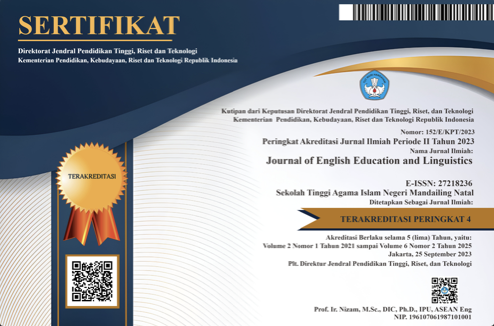ACADEMIC WRITING COMPETENCY BY USING BLENDED LEARNING STRATEGY
DOI:
https://doi.org/10.56874/jeel.v3i1.772Keywords:
Blended Learning, Academic Writing Subject, teaching and learningAbstract
Covid 19 disease has brought the new atmosphere for teaching and learning process. Where the real activity for lectures and students was very limited to do face-to-face activity. It is the fact that education and other side of world activity forced now. Learning from Home (LFH) as the one of alternative instructed by stakeholder to carry out the teaching and learning even though they are not in the classroom. This study present how the blended learning will be applied in academic writing Subject. This study is a case study design where the writer describes and evaluates blended learning in Academic Writing subject learning process to deliver the materials based on syllabus, writing practice by doing task, assignment submission and grading, students concern with the teachers’ elaboration and Foreign Language action and students evaluation. The participants will allow in this study are 13 students of ffifth semester students of English Education Program, Mandailing Natal Islamic State Collage. The data is collected through observation and short interview analysis. The result of this study shows that the students appreciated and benefited from the blended learning used in Academic Writing Subject. It help motivated the students to became independent learners and increase their ability in writing paragraph, essay, undergraduate proposal or thesis and so on.
References
Akkoyunlu.,.B.,.&Soylu.,.M.Y..(2015)..A.study.of.student’s.perceptions.in.a.blended.learning.e nvironment.based.on.different.learning.styles..International.Journal.of.Education.and.Dev elopment.using.Information.and.Communication.Technology(IJEDICT),.11. 80-100.
Amin,.E..(2016). Using ―Wikis‖ in developing writing performance and motivation among EFL students at Majmaah University. Faculty of Education Journal (Benha University), 27(105), 1–29. https://doi.org/10.12816/0028199
Bahrani, T. (2011). Computer assisted language learning—some aspects. Language in India, 11(9), 271-278.
Baker, W., & Bricker, R.H. (2010). The effects of direct and indirect speech acts on native English and ESL speakers‟ perception of teacher written feedback. System, 38, 75-84.
Barreto, A. M. R. (2011). Improving Writing through Stages. Improving Writing through Stages. How 18, 11–23.
Beatty, K. (2003). Teaching and researching computer-assisted language learning. London/New York: Pearson education Limited.
Belkhir, A., & Benyelles, R. (2017). Identifying EFL learners essay writing difficulties and sources: a move towards solution the case of second year EFL learners at Tlemcen University. International Journal of Learning, Teaching and Educational Research, 16, 80-88.
Chang, M-M. (2005). Applying self-regulated learning strategies in a web-based instruction—an investigation of motivation perception. Computer Assisted Language Learning, 18(3), 217-230.
Creswell, J.W. (2003). Research design qualitative, quantitative, and mixed methods methodes. California: Sage Publications, Inc.
Dudeney, G., & Hockly, N. (2007). How to teach English with technology. Essex: Pearson Education Limited.
Durga, V. S., & Rao, C. S. (2018). Developing students’ writing skills in English - A process method. Journal for Research
Eldeeb, R. (2013). Review and Critique of the Book "Education And Experience" by John Dewey. IOSR Journal of Research & Method in Education, 1(2), 44-47. Retrieved from www.iosrjournals.org/iosr-jrme/papers/Vol-1%20Issue2/I0124447.pdf?id=1665
Flower, L. and Hayes, J. R. (1981). A Cognitive Process Theory of Writing. doi:10.2307/356600. https://dx.doi.org/10.2307/356600.
Graham & J. Fitzgerald (Eds.), (2006) Handbook of Writing Research (pp. 144–157). N.Y: The Guilford Press.
Godwin-jones, R. (2011). Emerging Technologies Autonomous Language Learning, 15(3), 4– 11.
Hall, S., & Villareal, D. (2015). The Hybrid Advantage: Graduate Student Perspectives of Hybrid Education Courses. International Journal of Teaching and Learning in Higher Education, 27(1), 69-80.
Husamah. (2014). Pembelajaran Bauran (Blended Learning): Terampil Memadukan Keunggulan Pembelajaran Face-To-Face, E-Learning Offline-Online, dan Mobile Learning. Jakarta: Prestasi Pustaka.
Johnson, L. & Micheal, W.V. (2016). Methodes to teaching EMS: The teacher-centred methodes. 103-120.
Kessler, G. (2010). Fluency and anxiety in self-access speaking tasks: the influence of environment. Computer Assisted Language Learning, 23(4), 361-375.
McCall, H. (2017). Using microblogs on Facebook to develop students’ academic reading and writing skills. Retrieved from faculty.edfac.usyd.edu.au/projects/usp_in_tesol/pdf/volume12/Article05.pdf
Merriam, S.B. (1998). Qualitative research and case study application in education. San Fransisco: Jossey-Bass Publishers.
Nahmod, D. (2017). Vocabulary gamification vs traditional learning instruction in an inclusive high school classroom. Retrieved from http://rdw.rowan.edu/etd/2467
Oh, E., & Park, S. (2009). ―How are universities involved in blended instruction?‖ Educational Technology & Society, 12 (3).
Purnawarman, Susilawati, and Sundayana, (2016). The use of Edmodo in teaching writing in a blended learning setting. Indonesian Journal of Applied Linguistics, 5(2), 242-252. Retrieved from ejournal.upi.edu › Home › Vol 5, No 2 (2016)
Permana, & Gede, Y., (2017). The Effect of Using Blended Learning Method toward the 8 Grade Students’ Writing Skill. Journal of Psychology and Instruction Retrieved from http://ejournal.undiksha.ac.id/index.php/JoPaI/
Shih, R. (2011). Can Web 2.0 technology assist college students in learning English writing? Integrating Face book and peer
Scott, Caroline. 2009. Teaching English as an Additional Language. New York: Routledge
Westwood, P. (2008). What teachers need to know about reading and writing difficulties. Australia: Acer Press
Wichadee, S. (2017). A Development of the Blended Learning Model Using Edmodo for Maximizing Students’ Oral Proficiency and Motivation. International Journal of Emerging Technologies in Learning, 12(2), 137–154. http://doi.org/org/10.3991/ijet.v12i02.6324
Wold, K. A. (2011). Blending theories for instructional design: creating and implementing the structure, environment, experience, and people (SEEP) model. Computer Assisted Language Learning, 24(4), 371-382.
Yingwen, S. and Jian, S. (2016). A Study of Appreciation Resources In Teacher Feedback In The Chinese College EFL Context. Learning in and beyond the Classroom: Ubiquity in Foreign Language Education. The Seventh CLS International Conference CLaSIC, 443– 459.
Downloads
Published
Issue
Section
License
All articles published in the Journal of English Education and Linguistics are licensed under a Creative Commons Attribution-ShareAlike 4.0 International (CC BY-SA) license. This means anyone is free to copy, transform, or redistribute articles for any lawful purpose in any medium, provided they give appropriate attribution to the original author(s) and Journal of English Education and Linguistics, link to the license, indicate if changes were made, and redistribute any derivative work under the same license.
Copyright on articles is retained by the respective author(s) without restrictions. A non-exclusive license is granted to the Journal of English Education and Linguistics to publish the article and identify itself as its original publisher, along with the commercial right to include the article in a hardcopy issue for sale to libraries and individuals.
Although the conditions of the Creative Commons Attribution-ShareAlike 4.0 International (CC BY-SA) license do not apply to authors (as the copyright holder of your article, you have no restrictions on your rights), by submitting to the Journal of English Education and Linguistics, authors recognize the rights of readers and must grant any third party the right to use their articles to the extent provided by the license.

This work is licensed under a Creative Commons Attribution-ShareAlike 4.0 International License.








